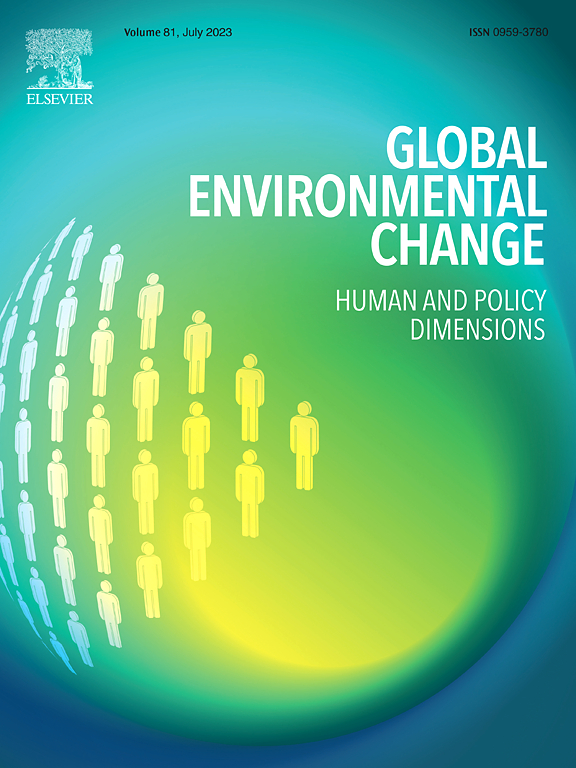Projected land-use change emissions surpass climate change-induced carbon sinks in Sub-Saharan African biomes
IF 9.1
1区 环境科学与生态学
Q1 ENVIRONMENTAL SCIENCES
引用次数: 0
Abstract
Land-use and land-cover change (LULCC) and climate change (CC) effects on carbon dynamics in Sub-Saharan Africa (SSA) have the potential to transition the region’s carbon balance from sink to source. Future shared socioeconomic pathways (SSPs) for SSA show high vulnerability to CC, high urbanisation, and cropland and pasture demands expected to rise in the coming decades. Yet the realisations of these pathways may be biome-specific as these are expected to behave differently when it comes to carbon dynamics and also be affected by different demands. Here, we examine the impacts of LULCC and CC on Net Ecosystem Exchange (NEE), Net Primary Productivity (NPP), and carbon turnover time of six SSA biomes, namely tropical rainforest, montane forest, moist savanna, dry savanna, temperate grassland and semi-desert, between 2015–2100 for the five SSPs. We performed four simulations where we (i) kept LULCC and CC constant, (ii) varied LULCC and kept CC constant, (iii) kept LULCC constant and varied CC, and (iv) varied both LULCC and CC and calculated their effect on NEE, NPP and carbon turnover time. We find that LULCC effects supersede those of CC, resulting in a net carbon source despite the sink effect of CC. LULCC alone drives major carbon losses across all scenarios, with moist and dry savannas resulting in the strongest carbon sources with cumulative NEE values of 74.93 and 44.85 PgC by 2100 under SSP4. In contrast, CC alone led to consistent carbon sinks across all scenarios in the semi-desert and tropical rainforest, with the strongest sinks observed under SSP5 (−8.36 PgC and − 3.77 PgC, respectively). Moist savanna also acted as a sink under SSP5 (−4.82 PgC) and SSP3 (−1.73 PgC). Combined effects largely reflect LULCC trends, confirming its dominant role in shaping future carbon dynamics. We further observe that intensifying LULCC may decrease biome carbon turnover time by 50 %, especially in tropical rainforests under SSP3 and SSP4. These results suggest that the CC-induced carbon sinks will unlikely dampen the increasing emissions from LULCC in SSA that may not be offset by 2100. Ultimately, our study demonstrates that sustaining SSA as a carbon sink will require urgent, biome-specific land management policies that integrate socioeconomic realities with the region’s evolving climate and development pathways.
预计的土地利用变化排放超过了撒哈拉以南非洲生物群落中气候变化引起的碳汇
撒哈拉以南非洲(SSA)土地利用和土地覆盖变化(LULCC)和气候变化(CC)对碳动态的影响有可能使该地区的碳平衡从汇向源转变。SSA未来的共享社会经济路径(ssp)显示出对CC、高度城市化以及预计在未来几十年将增加的耕地和牧场需求的高度脆弱性。然而,这些途径的实现可能是特定于生物群落的,因为当涉及到碳动力学时,这些途径的行为预计会有所不同,也会受到不同需求的影响。2015-2100年,研究了热带雨林、山地森林、湿润稀树草原、干燥稀树草原、温带草原和半荒漠6种SSA生物群落的净生态系统交换(NEE)、净初级生产力(NPP)和碳周转期的变化。我们进行了四种模拟,分别是(i)保持LULCC和CC不变,(ii)改变LULCC并保持CC不变,(iii)保持LULCC不变并改变CC,以及(iv)同时改变LULCC和CC并计算它们对新能源经济、NPP和碳转换时间的影响。研究发现,在SSP4情景下,到2100年,湿热带稀树草原和干热带稀树草原的累积NEE值分别为74.93和44.85 PgC,其净碳损失主要来自于LULCC。相比之下,在半沙漠和热带雨林的所有情景中,CC单独导致了一致的碳汇,其中SSP5情景下的碳汇最强(分别为- 8.36 PgC和- 3.77 PgC)。湿润稀树草原在SSP5 (- 4.82 PgC)和SSP3 (- 1.73 PgC)条件下也具有汇的作用。综合效应在很大程度上反映了LULCC趋势,证实了其在塑造未来碳动态中的主导作用。我们进一步观察到,在SSP3和SSP4下,LULCC的强化可使生物群落碳周转时间减少50%,特别是在热带雨林中。这些结果表明,碳汇不太可能抑制SSA中LULCC增加的排放,到2100年可能无法抵消。最后,我们的研究表明,维持SSA作为碳汇将需要紧急的、针对生物群落的土地管理政策,将社会经济现实与该地区不断变化的气候和发展路径结合起来。
本文章由计算机程序翻译,如有差异,请以英文原文为准。
求助全文
约1分钟内获得全文
求助全文
来源期刊

Global Environmental Change
环境科学-环境科学
CiteScore
18.20
自引率
2.20%
发文量
146
审稿时长
12 months
期刊介绍:
Global Environmental Change is a prestigious international journal that publishes articles of high quality, both theoretically and empirically rigorous. The journal aims to contribute to the understanding of global environmental change from the perspectives of human and policy dimensions. Specifically, it considers global environmental change as the result of processes occurring at the local level, but with wide-ranging impacts on various spatial, temporal, and socio-political scales.
In terms of content, the journal seeks articles with a strong social science component. This includes research that examines the societal drivers and consequences of environmental change, as well as social and policy processes that aim to address these challenges. While the journal covers a broad range of topics, including biodiversity and ecosystem services, climate, coasts, food systems, land use and land cover, oceans, urban areas, and water resources, it also welcomes contributions that investigate the drivers, consequences, and management of other areas affected by environmental change.
Overall, Global Environmental Change encourages research that deepens our understanding of the complex interactions between human activities and the environment, with the goal of informing policy and decision-making.
 求助内容:
求助内容: 应助结果提醒方式:
应助结果提醒方式:


